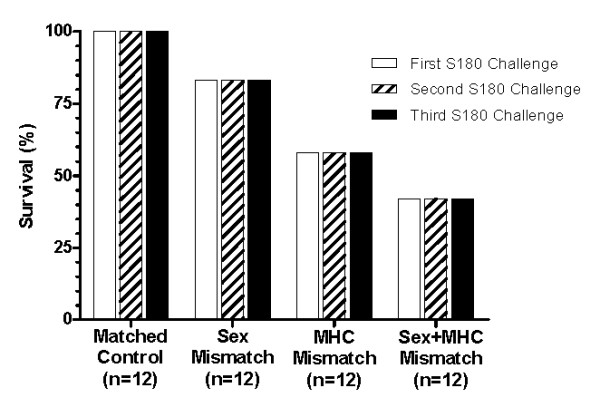Figure 1.

Functionality of donor leukocytes in mismatched recipients. The pooled donor leukocytes were evenly given to the recipients intraperitoneally (IP). After transfers of donor leukocytes, recipient mice were challenged with 1 × 106 S180 cells IP. The percent survival of the recipient mice was presented to indicate the functionality of the transferred donor leukocytes after the first challenge (left bars, 1 day after the transfer), second challenge (middle bars, 6 weeks after the transfer) and third challenge (right bars, 12 weeks after the transfer). All recipient mice were WT mice that were sensitive to S180 challenges. For the matched controls, 6 male BALB/c recipients were given male BALB/c SR/CR donor leukocytes and 6 female BALB/c recipients were given female BALB/c SR/CR donor leukocytes. For the sex mismatch, 6 female BALB/c recipients were given male BALB/c SR/CR donor leukocytes; 6 male BALB/c recipients were given female BALB/c SR/CR donor leukocytes. For the MHC mismatch, 6 male C57BL/6 mice were given male BALB/c SR/CR leukocytes and 6 female C57BL/6 mice were given female BALB/c SR/CR leukocytes. For the sex and MHC double mismatch, 6 female C57BL/6 mice were given male BALB/c SR/CR leukocytes and 6 male C57BL/6 mice were given female BALB/c SR/CR leukocytes. The percent survival for each of the adoptive transfers remains unchanged after each subsequent S180 challenge. The overall survival for each experimental group was as follows: matched is 100%, sex mismatch is 83%, MHC mismatch is 58%, and MHC + sex mismatch is 42%.
